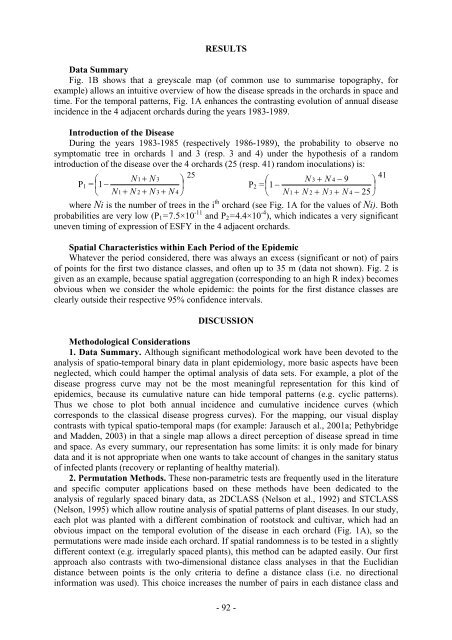Ecole Nationale Supérieure Agronomique de Montpellier ... - CIAM
Ecole Nationale Supérieure Agronomique de Montpellier ... - CIAM
Ecole Nationale Supérieure Agronomique de Montpellier ... - CIAM
Create successful ePaper yourself
Turn your PDF publications into a flip-book with our unique Google optimized e-Paper software.
RESULTS<br />
Data Summary<br />
Fig. 1B shows that a greyscale map (of common use to summarise topography, for<br />
example) allows an intuitive overview of how the disease spreads in the orchards in space and<br />
time. For the temporal patterns, Fig. 1A enhances the contrasting evolution of annual disease<br />
inci<strong>de</strong>nce in the 4 adjacent orchards during the years 1983-1989.<br />
Introduction of the Disease<br />
During the years 1983-1985 (respectively 1986-1989), the probability to observe no<br />
symptomatic tree in orchards 1 and 3 (resp. 3 and 4) un<strong>de</strong>r the hypothesis of a random<br />
introduction of the disease over the 4 orchards (25 (resp. 41) random inoculations) is:<br />
⎛ N1<br />
+ N<br />
25<br />
3 ⎞<br />
⎛ N 3 + N − 9<br />
41<br />
4 ⎞<br />
P1 = ⎜1−<br />
⎟ P2 = ⎜1<br />
−<br />
⎟<br />
⎝ N1<br />
+ N 2 + N 3 + N 4 ⎠<br />
⎝ N1<br />
+ N 2 + N 3 + N 4 − 25 ⎠<br />
where Ni is the number of trees in the i th orchard (see Fig. 1A for the values of Ni). Both<br />
probabilities are very low (P1 = 7.5×10 -11 and P2 = 4.4×10 -4 ), which indicates a very significant<br />
uneven timing of expression of ESFY in the 4 adjacent orchards.<br />
Spatial Characteristics within Each Period of the Epi<strong>de</strong>mic<br />
Whatever the period consi<strong>de</strong>red, there was always an excess (significant or not) of pairs<br />
of points for the first two distance classes, and often up to 35 m (data not shown). Fig. 2 is<br />
given as an example, because spatial aggregation (corresponding to an high R in<strong>de</strong>x) becomes<br />
obvious when we consi<strong>de</strong>r the whole epi<strong>de</strong>mic: the points for the first distance classes are<br />
clearly outsi<strong>de</strong> their respective 95% confi<strong>de</strong>nce intervals.<br />
DISCUSSION<br />
Methodological Consi<strong>de</strong>rations<br />
1. Data Summary. Although significant methodological work have been <strong>de</strong>voted to the<br />
analysis of spatio-temporal binary data in plant epi<strong>de</strong>miology, more basic aspects have been<br />
neglected, which could hamper the optimal analysis of data sets. For example, a plot of the<br />
disease progress curve may not be the most meaningful representation for this kind of<br />
epi<strong>de</strong>mics, because its cumulative nature can hi<strong>de</strong> temporal patterns (e.g. cyclic patterns).<br />
Thus we chose to plot both annual inci<strong>de</strong>nce and cumulative inci<strong>de</strong>nce curves (which<br />
corresponds to the classical disease progress curves). For the mapping, our visual display<br />
contrasts with typical spatio-temporal maps (for example: Jarausch et al., 2001a; Pethybridge<br />
and Mad<strong>de</strong>n, 2003) in that a single map allows a direct perception of disease spread in time<br />
and space. As every summary, our representation has some limits: it is only ma<strong>de</strong> for binary<br />
data and it is not appropriate when one wants to take account of changes in the sanitary status<br />
of infected plants (recovery or replanting of healthy material).<br />
2. Permutation Methods. These non-parametric tests are frequently used in the literature<br />
and specific computer applications based on these methods have been <strong>de</strong>dicated to the<br />
analysis of regularly spaced binary data, as 2DCLASS (Nelson et al., 1992) and STCLASS<br />
(Nelson, 1995) which allow routine analysis of spatial patterns of plant diseases. In our study,<br />
each plot was planted with a different combination of rootstock and cultivar, which had an<br />
obvious impact on the temporal evolution of the disease in each orchard (Fig. 1A), so the<br />
permutations were ma<strong>de</strong> insi<strong>de</strong> each orchard. If spatial randomness is to be tested in a slightly<br />
different context (e.g. irregularly spaced plants), this method can be adapted easily. Our first<br />
approach also contrasts with two-dimensional distance class analyses in that the Euclidian<br />
distance between points is the only criteria to <strong>de</strong>fine a distance class (i.e. no directional<br />
information was used). This choice increases the number of pairs in each distance class and<br />
- 92 -



